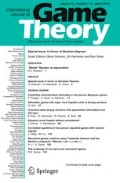Abstract
A pillage game is a coalitional game in which any coalition can take all or part of the wealth of any less powerful coalition. Such an action is called pillage. In the majority pillage game, coalitional wealth contributes to coalitional power, but lexicographically less so than coalitional size. The majority pillage game refines the classic majority game in two respects. First, coalitional wealth can resolve ties in coalitional size. Second, a pillaging coalition need not contain a majority or even half of all of the players in the game. A majority of the players directly affected by the pillage, as winners or losers, is sufficient. This paper characterizes the stable sets of two and three-player games, and the symmetric (permutation invariant) stable sets of games with more than three players. For two or three players, the stable set is unique, and for any odd number of players, the symmetric stable set is unique and equal to the unique symmetric stable set for the classic majority game. If the number of players is even and at least four, no symmetric stable set exists.




Similar content being viewed by others
References
Asilis C, Kahn C (1992) Semi-stability in game theory: a survey of ugliness. In: Dutta B et al (eds) Game theory and economic applications. Springer, Berlin
Bott R (1953) Symmetric solutions to majority games. Contributions to the theory of games, annals of mathematical studies, vol. II, 28th edn. Princeton University Press, Princeton
Jordan J (2006) Pillage and property. J Econ Theory 131:26–44
Lucas W (1992) Von Neumann-Morgenstern stable sets. In: Aumann R, Hart S (eds) Handbook of game theory. Elsevier Science Publishers B.V., Amsterdam
Roth A (1976) Subsolutions and the supercore of cooperative games. Math Oper Res 1:43–49
Von Neumann J, Morgenstern O (1947) Theory of games and economic behavior. Wiley, New York
Author information
Authors and Affiliations
Corresponding author
Additional information
Helpful conversations with Colin Rowat and useful comments of an anonymous referee are gratefully acknowledged.
Rights and permissions
About this article
Cite this article
Jordan, J., Obadia, D. Stable sets in majority pillage games. Int J Game Theory 44, 473–486 (2015). https://doi.org/10.1007/s00182-014-0440-z
Accepted:
Published:
Issue Date:
DOI: https://doi.org/10.1007/s00182-014-0440-z




